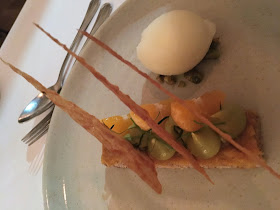Recently, I went on vacation to the north island of New Zealand with my family. Like last time, I took the opportunity to try some unique New Zealand treats.
There are a few Kiwis in my office, and more than one had never heard of Lolly Cake. I decided to make it my mission to bring them up to speed on Lolly Cake, and bought some Eskimo sweets in New Zealand to do just that.
Eskimos are foam marshmallow sweets in pink, yellow, white and green colours, made by Pascall. The packet states: "These cute little guys chill out in New Zealand. You would think they would prefer somewhere colder but it's a good job for us they don't!"
Lolly cake is New Zealand's answer to Hedgehog - it is a refrigerator cake made with Eskimos, malted milk biscuits, condensed milk, butter and coconut. It is a melt and mix jobbie, so anyone can make it.
If you are curious enough to make it, the recipe is as follows:
1 packet Eskimo lollies (or ~200g other foam lollies, like bananas)
1 x 250g packet malted milk biscuits (graham crackers would also work well here)
200g condensed milk (~ 1/2 can)
120g butter
dessicated coconut sufficient to roll the cake in
Break the Eskimos into bite sized pieces with your hands, and crush the malted milk biscuits roughly into crumbs with the end of a rolling pin. Put the Eskimo and biscuit pieces together in a large bowl.
Melt the condensed milk and butter together in a saucepan until smooth, then pour over the crumbs and Eskimo pieces. Mix together until well combined.
Turn the mixture out onto a long piece of cling film, and using the film for assistance, roll the mixture into a long log roughly 5cm in diameter. Roll the log in dessicated coconut until the outside is thoroughly coated, then wrap the log back in the cling film and refrigerate for a couple of hours until firmly set.
Cut the log into coins ~1cm wide and serve.
While in New Zealand, we attended a hangi at Tamaki Maori Village in Rotorua:
The guy on the right is our chief, hence the huia feathers in his hair. A hangi is actually the pit where food is cooked on heated stones. The above photo shows the vegetables and meats (fish and lamb) cooked in the hangi.
The hangi was served to us non-traditionally in a warm dining room away from the rain and cold, with plenty of sides and condiments:
There was also dessert of pavlova, peaches and butterscotch pudding (also non-traditional) afterwards. I sat next to a lovely young couple from California who had spent the day zorbing.
I love visiting supermarkets in places outside of Australia, and New Zealand was no exception.
I bought this apricot and ginger jam at Pak'n'Save in Rotorua:
I also bought the Eskimos plus Lolly Scramble (assorted wrapped lollies) and a Party Pack (assorted jubes) at Pak'n'Save:
In Countdown in Rotorua and Napier, I picked up these unusual flavours of Whittakers chocolates, which we pay a small fortune for here in Australia:
My favourite is still the Nelson Pear and Manuka Honey that I had bought in Australia for double the price.
While in Napier, I bought the very cool Six Sisters Café teatowel that you can see at the top of this post. The Six Sisters are six identical houses of different colours built along Marine Parade, one for each of a gentleman's daughters. These days the houses are occupied by various activities, including the café.
At the café, I also bought these three slices for my family to share:
Left to right, they are coffee and cashew, peanut butter and jelly, and ginger crunch. The latter was the winner for me.
At the Wellington Underground Market, Mum bought me this Conitos La Casa from the La Casa Alfajores stand:
It comprises a chocolate biscuit, atop which is a maraschino cherry and a mound of dulce de leche. The whole lot is then enrobed in chocolate:
Delicious!! It is an Argentinean treat.
While in Wellington, we had breakfast at Columbus Coffee on Sunday morning. I could not go past the pancake stack with grilled banana, bacon and maple syrup:
At another café, I bought this wonderful Deep Spring Pear and Passion Mineral Water with only 73 calories:
I wish that we'd get this drink here in Australia. So good, just like a soft drink without all the calories.
So there you go - a quick culinary hop through the North Island and a takeaway Kiwi recipe to try.



















































